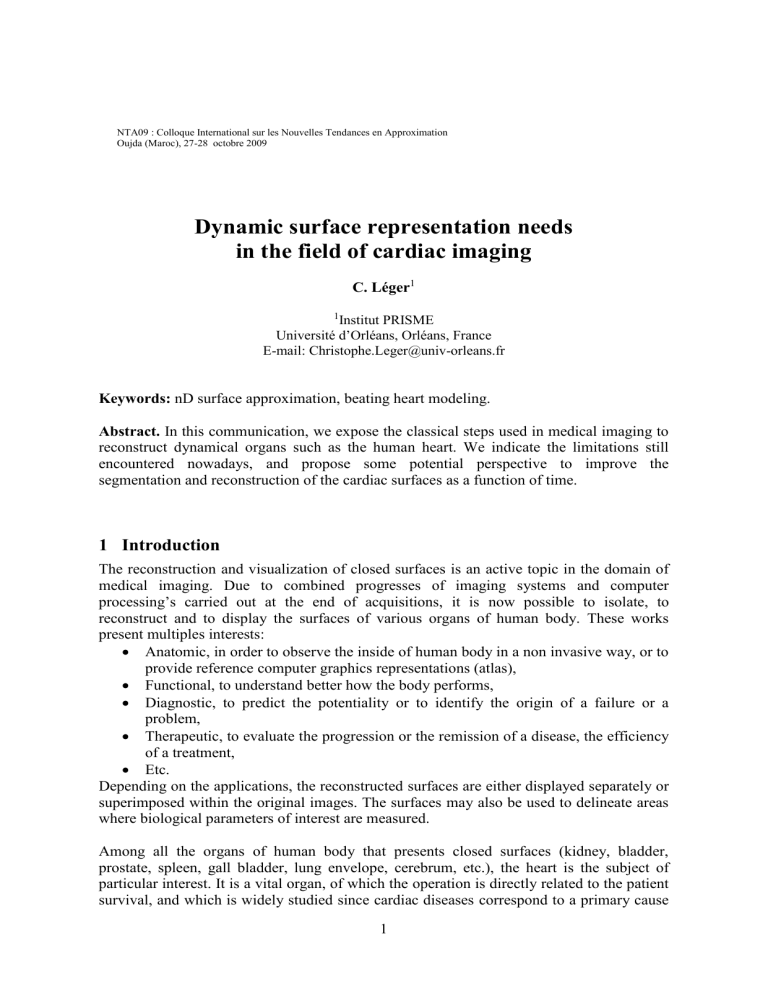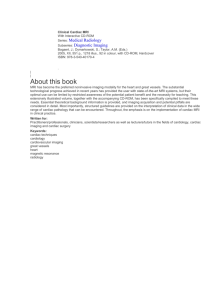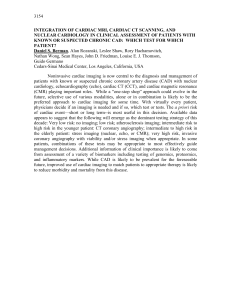Dynamic surface representation needs in the field of cardiac

NTA09 : Colloque International sur les Nouvelles Tendances en Approximation
Oujda (Maroc), 27-28 octobre 2009
Dynamic surface representation needs in the field of cardiac imaging
C. Léger 1
1
Institut PRISME
Université d’Orléans, Orléans, France
E-mail: Christophe.Leger@univ-orleans.fr
Keywords: nD surface approximation, beating heart modeling.
Abstract.
In this communication, we expose the classical steps used in medical imaging to reconstruct dynamical organs such as the human heart. We indicate the limitations still encountered nowadays, and propose some potential perspective to improve the segmentation and reconstruction of the cardiac surfaces as a function of time.
1 Introduction
The reconstruction and visualization of closed surfaces is an active topic in the domain of medical imaging. Due to combined progresses of imaging systems and computer processing’s carried out at the end of acquisitions, it is now possible to isolate, to reconstruct and to display the surfaces of various organs of human body. These works present multiples interests:
Anatomic, in order to observe the inside of human body in a non invasive way, or to provide reference computer graphics representations (atlas),
Functional, to understand better how the body performs,
Diagnostic, to predict the potentiality or to identify the origin of a failure or a problem,
Therapeutic, to evaluate the progression or the remission of a disease, the efficiency of a treatment,
Etc.
Depending on the applications, the reconstructed surfaces are either displayed separately or superimposed within the original images. The surfaces may also be used to delineate areas where biological parameters of interest are measured.
Among all the organs of human body that presents closed surfaces (kidney, bladder, prostate, spleen, gall bladder, lung envelope, cerebrum, etc.), the heart is the subject of particular interest. It is a vital organ, of which the operation is directly related to the patient survival, and which is widely studied since cardiac diseases correspond to a primary cause
1
C. Léger of death in the industrial countries, and therefore represents a major challenge of public health. In consequence, cardiac imaging exploits all medical imaging modalities, that is to say structural imaging, as ultrasound (echography), X rays (CT-scan) and magnetic resonance imaging (MRI), or functional imaging, as nuclear medicine (SPECT).
2 Method
The methods carried out to reconstruct the deformations of the surfaces of the heart as a function of time require generally 5 major steps:
1.
Acquisition of bi (2D), tri (3D) or even quadri (4D) dimensional images,
2.
Determination of the cardiac contours by image segmentation using 2D, 3D or 4D algorithms,
3.
Association of the samples provided by contour segmentation, in order to produce deformable surfaces as a function of time,
4.
Surface smoothing, often necessary because of the noise added to the samples,
5.
Samples reorganization (using triangulation algorithms), then representation.
The segmentation step (#2) strongly depends on the nature and the quality of the original
images. It represents the most complex step of the process to carry out.
Figure 1 presents cardiac images produced from four classical imaging modalities, which
differ by their signal to noise ratio and their resolution.
(a) (b) (c) (d)
Figure 1: example of cardiac images. (a) ultrasound image (512
512), (b) nuclear medicine image (64
64), (c) MRI image (256
256), d) X-Ray image (256
256).
To segment such cardiac images, the standard techniques of image processing used to locate the contours using derivative/differentiation methods are not efficient. This is particularly due to invisible portions of contours that have to be extrapolated because they do not exist, for example when the mitral valves between the left atrium and the lower part of the left ventricle are widely opened (cf. white stain at the bottom of the contour on
Figure 1a,). To deal with this problem, algorithms based on active contours [1] or surfaces
[2] are preferred, since they present the advantage to associate image information
with a priori information on the shape or position of the expected contours or surfaces. Adding contour or surface information allows compensating the lack of information of the images.
By setting constraints, the degrees of freedom of the segmentation algorithms are limited, and contour or surface evolvement is contained within probable domains compatible with reality. Thus, cardiac images known to be difficult to segment can be exploited by physicians.
3 Limitations
In order to reduce the complexity of the implemented algorithms, or limit the duration of the processing times, problems are sometimes resolved at lower dimensions than expected.
Then, results are gathered to get back to the dimension of the initial problems and to provide acceptable solutions. For example, cardiac contours obtained at multiple levels
2
Dynamic surface representation needs in the field of cardiac imaging
(altitudes) are assembled to reconstruct a single surface of the heart (in opposition to 3D, the term 2D ½ is used to identify this type of reconstruction), or various surfaces are
associated to represent the surface of the heart that varies as a function of time [3] (3D ½ is
used instead of 4D). Unfortunately, such approaches introduce breaks of continuity, either spatially (2D ½), or temporally (3D ½). The only solution to deal with this problem is to carry out a posteriori additional approximations, in order to guarantee the regularity of the representations. Moreover, these approximations are useful to correct the uncertainty (due to noise) of the contours or surfaces samples provided at the end of the segmentation step,
despite of the use of complex models [4], or the implementation of active contour or
surface algorithms. The reconstruction errors are then corrected a posteriori using regularizing methods.
4 Conclusion
To reconstruct accurately the deformations of the heart and/or its cavities as a function of
time (Figure 2), true 4D approaches must be developed, in order to take into account all the
available information to compute each useful sample of the surface. Such approaches began
to appear [5], whereas others can be extended directly to 4D [6]. It remains to complete
these methods, and to try to merge them with active surface algorithms in order to get tools that combine estimation and regularization at each step of the processes.
Figure 2: example of 8 surfaces of the left ventricle of the heart reconstructed within a cardiac cycle.
REFERENCES
[1] M. Kass, A. Witkin, D. Terzopoulos, Snakes: Active contour models, International
Journal of Computing and Vision , Vol. 1, pp. 321–331, 1988.
[2] T. F. Chan, L. A. Vese, Active Contours Without Edges, IEEE Transactions on Image
Processing , Vol. 10, n°2, February 2001.
[3]
J. C. Souplet, C. Léger, V. Eder, Representation of the LV 3D phase dispersion using gated spect blood pool tomography, Computers in cardiology , pp. 419 – 422, Sept 25–
28, Lyon, 2005.
[4] R. Haddad, P. Clarysse, M. Orkisz, D. Revel and I. Magnin, An anthropomorphic numerical model of the beating heart, ITBM-RBM, Vol. 26, n° 4, pp. 270–272,
September 2005.
[5] Cl. Bonciu, R. Weber, C. Léger, 4D reconstruction of the left ventricle during a single heart beat, from ultrasound imaging, Image and Vision Computing, Elsevier Eds, Vol.
19, N°6, pp. 401-412, April 2001.
[6] E. B. Ameur, D. Sbibih, A. Almhdie, C. Léger , New spline quasi-interpolant for fitting
3D data on the sphere: Applications to medical imaging, IEEE Signal Processing
Letters
, Vol. 14, n° 5, pp. 333–336, May 2007.
3








